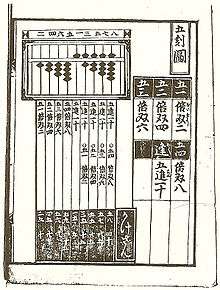Yoshida Mitsuyoshi

Yoshida Mitsuyoshi (吉田 光由, 1598 – January 8, 1672), also known as Yoshida Kōyū, was a Japanese mathematician in the Edo period.[1] His popular and widely disseminated published work made him the most well known writer about mathematics in his lifetime.[2]
He was a student of Kambei Mori (also known as Mōri Shigeyoshi). Along with Imamura Chishō and Takahara Kisshu, Yoshida became known to his contemporaries as one of "the Three Arithmeticians."[3]
Yoshida was the author of the oldest extant Japanese mathematical text. The 1627 work was named Jinkōki. The work dealt with the subject of soroban arithmetic, including square and cube root operations.[4]
Selected works
In a statistical overview derived from writings by and about Yoshida Mitsuyoshi, OCLC/WorldCat encompasses roughly 20+ works in 30+ publications in 1 language and 40+ library holdings.[5]
- 1643 — Jinkōki (塵劫記), OCLC 22023455088
- 1659 — Shinpen Jinkōki (新編塵劫記), OCLC 22057549632
- 1818 — Sanpō chiedakara (筭法智惠寳), OCLC 22057124215
- 1850 — Chikamichi Jinkōki' (近道塵劫記), OCLC 22055982082
See also
- Sangaku, the custom of presenting mathematical problems, carved in wood tablets, to the public in shinto shrines
- Soroban, a Japanese abacus
- Japanese mathematics (wasan)
Notes
- ↑ List of Japanese mathematicians -- Clark University, Dept. of Mathematics and Computer Science.
- ↑ Horiuchi, Annick. (1994). Les Mathematiques Japonaises a L'Epoque d'Edo (1600–1868), pp. 33-34. , p. 33, at Google Books
- ↑ Smith, David. (1914) A History of Japanese Mathematics, p. 35., p. 35, at Google Books)
- ↑ Restivo, Sal P. (1992). Mathematics in Society and History. Springer 1992, ISBN 978-0-7923-1765-4, p. 56., p. 56, at Google Books
- ↑ WorldCat Identities: 吉田光由 1598-1672
References
- Endō Toshisada (1896). History of mathematics in Japan (日本數學史史 Dai Nihon sūgakush). Tōkyō: _____. OCLC 122770600
- Horiuchi, Annick. (1994). Les Mathematiques Japonaises a L'Epoque d'Edo (1600–1868): Une Etude des Travaux de Seki Takakazu (?-1708) et de Takebe Katahiro (1664–1739). Paris: Librairie Philosophique J. Vrin. ISBN 9782711612130; OCLC 318334322
- Restivo, Sal P. (1992). Mathematics in Society and History: Sociological Inquiries. Dordrecht: Kluwer Academic Publishers. ISBN 9780792317654; OCLC 25709270
- David Eugene Smith and Yoshio Mikami. (1914). A History of Japanese Mathematics. Chicago: Open Court Publishing. OCLC 1515528 -- note alternate online, full-text copy at archive.org
External links